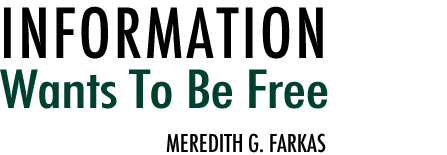by David King, newly of the Topeka and Shawnee Public Library
David showed a whole bunch of library Websites that give users a really bad experience. There was one where they actually asked users whether they wanted a Flash or HTML Web site before they could get to the front page. Crazy! Then he showed Flickr and how when they went down, they were honest and transparent about it and had a contest to give users a fun experience. While people could have been mad that Flickr was down, instead, they had a lot of fun. It’s all about the way we design our experience.
We want users to focus on themselves, on finding what they want.
David recommends Jesse James Garrett’s “The Elements of User Experience.”
Five Elements of User Experience Design:
- Strategy – planning
- Scope – focus on what content is needed on the site and what functional specs you need. Who will do what.
- Structure – Interaction design (application flows for user tasks, the process to complete a task). Information architecture. Fill in the details.
- Skeleton – wire-framing. You’re focused on where the information will appear on the page. Layout. Outline of the site.
- Surface – Visual design of the site.
Experience Economy – new concept in the marketing and architecture world.
Types of experiences:
- Memorable
- Choreographed
- Positive
- Invisible – things you don’t notice because they work so well. You shouldn’t notice a Web site. You want to connect with the information not the Web site.
- Negative
- Ordinary
How to do this:
- Ask the user – Ask your patrons what they’d like to see change. Ask your staff what they’d like to see change or what they’d like us to provide to patrons. Remember that the needs of staff and patrons can often be different.
- Help the user to save extra steps. What extra steps exist on your Web site? How can you make it as easy as possible for users to do what they want to do?
- Find trigger points – what makes someone like or hate the experience? What do you not like about our site? How can we improve that?
- Improve the dinosaurs – find something that hasn’t changed in a long time and make it better
- Map a journey – understand a customer’s journey on their site and their state of mind.
- Merit badging – people are collecting experiences, rather than things.
- Focused design – seamless and focused with your design. No hiccups. Remove distractions. Consistent look and feel.
Pretend you’re a patron for a minute and see how you would feel about your Website if you were not a librarian.

Hi Meredith,
I’m assuming, like any obsessed Webite, you’ll be checking your blog even while you’re on vaca in California. If not, shame on you or good for you.
I attended a couple presentations by Adaptive Path folks while I was in Denver and was impressed with their strategic and tactical insights. Jesse James and Jefffery both have a lot to offer.
I also recommend Elements of User Experience. I found it informative, but I find it especially useful for leaving with non-Web folks to help them get a good overview of the complexities and various disciplines involved in quality Web work. I also like Steve Krug’s “Don’t Make me Think” for the same reasons.
ta ta for now,
Eric